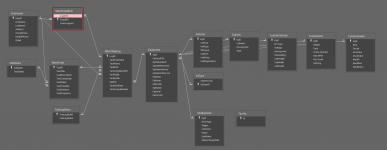JMongi
Active member
- Local time
- Today, 18:14
- Joined
- Jan 6, 2021
- Messages
- 802
Here's a simplified version of part of my DB structure via record, not by fields:
Equipment
EQ1
EQ2
...
Facility
FC1
FC2
...
Unit
0200
0201
...
Vehicle
VE1
VE2
...
MaintTaskLog
MTL1
MTL2
....
Each of these tables has unique ID's to identify the record as you would expect. In order to construct a maintenance task log (MTL) record via form, one of the necessary tasks is selecting which item from the other four tables above is receiving said maintenance. It seemed the way to do this would be:
1. User selects one of 4 categories from combo box (Equipment, Facility, Vehicle, Unit)
2. This selection populates the second combo box with the appropriate list query.
3. User selects the appropriate item from the second combo box.
4. After this selection is made, the appropriate ID is pulled from the query ready to be stored in the chosen field in the MTL table record.
Is this the right type of process? I thought I would double check before I went to far down the form rabbit hole for the Task Log.
Equipment
EQ1
EQ2
...
Facility
FC1
FC2
...
Unit
0200
0201
...
Vehicle
VE1
VE2
...
MaintTaskLog
MTL1
MTL2
....
Each of these tables has unique ID's to identify the record as you would expect. In order to construct a maintenance task log (MTL) record via form, one of the necessary tasks is selecting which item from the other four tables above is receiving said maintenance. It seemed the way to do this would be:
1. User selects one of 4 categories from combo box (Equipment, Facility, Vehicle, Unit)
2. This selection populates the second combo box with the appropriate list query.
3. User selects the appropriate item from the second combo box.
4. After this selection is made, the appropriate ID is pulled from the query ready to be stored in the chosen field in the MTL table record.
Is this the right type of process? I thought I would double check before I went to far down the form rabbit hole for the Task Log.


